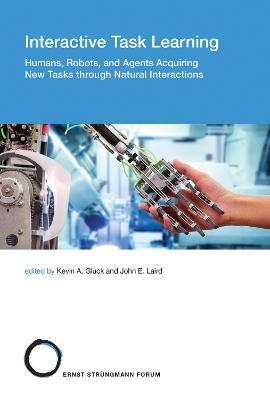
Interactive Task Learning
Humans, Robots, and Agents Acquiring New Tasks through Natural Interactions
Seiten
2019
MIT Press (Verlag)
978-0-262-03882-9 (ISBN)
MIT Press (Verlag)
978-0-262-03882-9 (ISBN)
Experts from a range of disciplines explore how humans and artificial agents can quickly learn completely new tasks through natural interactions with each other.
Humans are not limited to a fixed set of innate or preprogrammed tasks. We learn quickly through language and other forms of natural interaction, and we improve our performance and teach others what we have learned. Understanding the mechanisms that underlie the acquisition of new tasks through natural interaction is an ongoing challenge. Advances in artificial intelligence, cognitive science, and robotics are leading us to future systems with human-like capabilities. A huge gap exists, however, between the highly specialized niche capabilities of current machine learning systems and the generality, flexibility, and in situ robustness of human instruction and learning. Drawing on expertise from multiple disciplines, this Strungmann Forum Report explores how humans and artificial agents can quickly learn completely new tasks through natural interactions with each other.
The contributors consider functional knowledge requirements, the ontology of interactive task learning, and the representation of task knowledge at multiple levels of abstraction. They explore natural forms of interactions among humans as well as the use of interaction to teach robots and software agents new tasks in complex, dynamic environments. They discuss research challenges and opportunities, including ethical considerations, and make proposals to further understanding of interactive task learning and create new capabilities in assistive robotics, healthcare, education, training, and gaming.
Contributors
Tony Belpaeme, Katrien Beuls, Maya Cakmak, Joyce Y. Chai, Franklin Chang, Ropafadzo Denga, Marc Destefano, Mark d'Inverno, Kenneth D. Forbus, Simon Garrod, Kevin A. Gluck, Wayne D. Gray, James Kirk, Kenneth R. Koedinger, Parisa Kordjamshidi, John E. Laird, Christian Lebiere, Stephen C. Levinson, Elena Lieven, John K. Lindstedt, Aaron Mininger, Tom Mitchell, Shiwali Mohan, Ana Paiva, Katerina Pastra, Peter Pirolli, Roussell Rahman, Charles Rich, Katharina J. Rohlfing, Paul S. Rosenbloom, Nele Russwinkel, Dario D. Salvucci, Matthew-Donald D. Sangster, Matthias Scheutz, Julie A. Shah, Candace L. Sidner, Catherine Sibert, Michael Spranger, Luc Steels, Suzanne Stevenson, Terrence C. Stewart, Arthur Still, Andrea Stocco, Niels Taatgen, Andrea L. Thomaz, J. Gregory Trafton, Han L. J. van der Maas, Paul Van Eecke, Kurt VanLehn, Anna-Lisa Vollmer, Janet Wiles, Robert E. Wray III, Matthew Yee-King
Humans are not limited to a fixed set of innate or preprogrammed tasks. We learn quickly through language and other forms of natural interaction, and we improve our performance and teach others what we have learned. Understanding the mechanisms that underlie the acquisition of new tasks through natural interaction is an ongoing challenge. Advances in artificial intelligence, cognitive science, and robotics are leading us to future systems with human-like capabilities. A huge gap exists, however, between the highly specialized niche capabilities of current machine learning systems and the generality, flexibility, and in situ robustness of human instruction and learning. Drawing on expertise from multiple disciplines, this Strungmann Forum Report explores how humans and artificial agents can quickly learn completely new tasks through natural interactions with each other.
The contributors consider functional knowledge requirements, the ontology of interactive task learning, and the representation of task knowledge at multiple levels of abstraction. They explore natural forms of interactions among humans as well as the use of interaction to teach robots and software agents new tasks in complex, dynamic environments. They discuss research challenges and opportunities, including ethical considerations, and make proposals to further understanding of interactive task learning and create new capabilities in assistive robotics, healthcare, education, training, and gaming.
Contributors
Tony Belpaeme, Katrien Beuls, Maya Cakmak, Joyce Y. Chai, Franklin Chang, Ropafadzo Denga, Marc Destefano, Mark d'Inverno, Kenneth D. Forbus, Simon Garrod, Kevin A. Gluck, Wayne D. Gray, James Kirk, Kenneth R. Koedinger, Parisa Kordjamshidi, John E. Laird, Christian Lebiere, Stephen C. Levinson, Elena Lieven, John K. Lindstedt, Aaron Mininger, Tom Mitchell, Shiwali Mohan, Ana Paiva, Katerina Pastra, Peter Pirolli, Roussell Rahman, Charles Rich, Katharina J. Rohlfing, Paul S. Rosenbloom, Nele Russwinkel, Dario D. Salvucci, Matthew-Donald D. Sangster, Matthias Scheutz, Julie A. Shah, Candace L. Sidner, Catherine Sibert, Michael Spranger, Luc Steels, Suzanne Stevenson, Terrence C. Stewart, Arthur Still, Andrea Stocco, Niels Taatgen, Andrea L. Thomaz, J. Gregory Trafton, Han L. J. van der Maas, Paul Van Eecke, Kurt VanLehn, Anna-Lisa Vollmer, Janet Wiles, Robert E. Wray III, Matthew Yee-King
Kevin A. Gluck is a Principal Cognitive Scientist at the U.S. Air Force Research Laboratory. John E. Laird is John L. Tishman Professor of Engineering in the Computer Science and Engineering Department at the University of Michigan.
| Erscheinungsdatum | 01.10.2019 |
|---|---|
| Reihe/Serie | Strüngmann Forum Reports ; 26 |
| Zusatzinfo | 9 color illus., 5 b&w illus., 22 halftones |
| Sprache | englisch |
| Maße | 152 x 229 mm |
| Themenwelt | Geisteswissenschaften ► Psychologie ► Allgemeines / Lexika |
| Informatik ► Theorie / Studium ► Künstliche Intelligenz / Robotik | |
| ISBN-10 | 0-262-03882-X / 026203882X |
| ISBN-13 | 978-0-262-03882-9 / 9780262038829 |
| Zustand | Neuware |
| Informationen gemäß Produktsicherheitsverordnung (GPSR) | |
| Haben Sie eine Frage zum Produkt? |
Mehr entdecken
aus dem Bereich
aus dem Bereich
Buch | Softcover (2024)
REDLINE (Verlag)
CHF 27,95
Eine kurze Geschichte der Informationsnetzwerke von der Steinzeit bis …
Buch | Hardcover (2024)
Penguin (Verlag)
CHF 39,20


